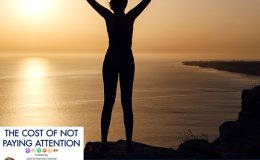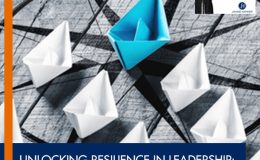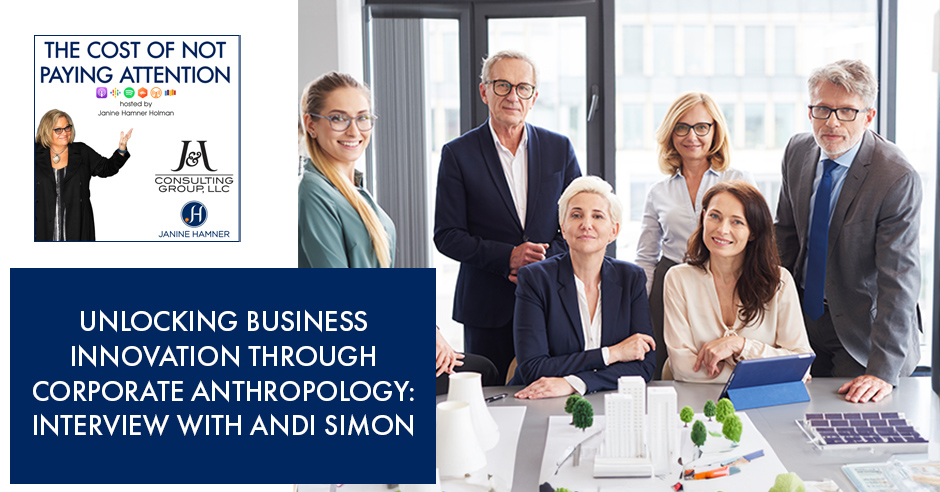
In today’s rapidly evolving business landscape, corporate anthropology offers a powerful tool for organizations seeking to stay ahead of the curve and achieve long-term success. In this episode, Janine Hamner Holman welcomes Dr. Andi Simon, a corporate anthropologist and founder and CEO of Simon Associates Management Consultants. Dr. Andi shares eye-opening insights on how ethnographic research can unlock hidden opportunities and drive transformative change. Through case studies in healthcare and manufacturing, she shows how ethnographic research drives change. Learn how to embrace uncertainty and inclusion while leveraging human behavior insights to drive innovation.
GUEST: Dr. Andi Simon | LinkedIn | Visit their Website: Simon Associates Management Consultants
HOST: Janine Hamner Holman | Janine@JandJCG.com | LinkedIn, Facebook, and Twitter | Subscribe to my Newsletter! | Book me to Speak!
—
Listen to the podcast here
Unlocking Business Innovation Through Corporate Anthropology: Interview With Andi Simon
Ethnographic Work
Welcome to the show. I am thrilled to introduce you to our guest. Dr. Andi Simon is a Corporate Anthropologist, guiding companies through transformative change. She’s the architect of a global thought leadership platform that blends academic perspectives, depth and breadth of business experience, written work, new media expertise, and proven success in changing corporate cultures and growing businesses. She’s also the author of three books, each one of which has a really fantastic title. Check these out.
Women Mean Business: Over 500 Insights from Extraordinary Leaders to Spark Your Success. On the Brink: A Fresh Lens to Take Your Business to New Heights. Rethink: Smashing the Myths of Women in Business. I love it. They’re so great. Andi, welcome to the show. Tell me, what’s the one thing that either within your business or working with your clients that you have realized that either you or your clients have been failing to pay attention to? What’s the problem that that inattention is causing?
Janine, I am very delighted to be here. As an anthropologist, my job is to help my clients see things through a fresh lens. I often will take a client to do ethnographic work. If I take them out, it’s more difficult for them to say, “No, that’s not what we saw.” We are looking at things through very different perspectives. I’ll start with one case, but I’ll make sure there are 2 or 3 others from different industries. Regardless of who your audience is, there’s something particularly relevant. One of my favorite stories is that I spent about seven years in hospital healthcare.
When I launched my business, one of my former bosses asked me to be his acting SVP for a whole lot of stuff out in the Midwest. I don’t need to tell the title or the name of the hospital itself because they asked me not to, but it works as a case. As an anthropologist, people say, “What do you do?” I say, “Hang out.” You begin to observe things. If you’re losing $25 million or $30 million, we need to figure out what’s going on. More of the same, even if you try and do it cheaper, it’s not easy to do. There’s no revenue on the positive side to offset the negative.
If you’re going to keep everyone happy doing more of the same of what you’ve always done, you’re either going to shrink your staff or you’re going to not have good patient care. What are you trying to do? We began to look at opportunities to shift the focus from a lot of the doctors. We’re doing things that were nice for the doctor but harmful to the organization itself. They were often very happy to be made director of this or director of that and get nice salaries. All of these were eating away from the revenue that we could use to go into patient care at the hospital.
Now, that meant you had to begin to tell doctors, no, they no longer could be in those positions. Since there were competitors that they could go and put their patients in, it was very risky. On the other hand, patients were, by and large, people without health insurance. We had a hospital where I’m particularly happy getting them. The failed part was that the risk really wasn’t a risk because there was no place else for those patients to easily go. The doctors realized very quickly that this was not going to keep the hospital afloat and if it died, then they’d have no place to easily admit their patients.
It became a wonderful conversation. Now, I learned all kinds of other things like people were afraid to come to this hospital. If you hung out in the lobby, you realized when they arrived, it was unfamiliar. Most people don’t spend time wandering around hospitals getting to know each other. I had part of my responsibility on that patient experience. I said, “Why don’t we provide them with guides? Mentors guide, call them whatever you like, but they sting out of coming to a strange place.”
There wasn’t anything peculiar about the place or about them except the unfamiliar made people uncomfortable. Those guys were terrific at helping patients who would get their information before they arrived so somebody would be waiting for them. It took the uncertainty. Humans hate uncertainty and make it much more comfortable and familiar. When they were in there, there was someone to count on to come in and see how they were doing.
Navigating Uncertainty
I want to jump into the story with you here for a second because what you did is just that one teeny thing of realizing. When people get to the hospital, it’s unfamiliar. They don’t know what to do. As you said, humans hate uncertainty. One of the big challenges of working with this machine in our heads called our brains is that that brain hates uncertainty. Usually, when we’re going to a hospital, we’re a little bit concerned about something that’s happening either inside our body or inside the body of a loved one.
We’re usually not going to the hospital because we want to eat their amazing food or because we want to have a hoedown dance. It’s not an exciting thing to do. Something’s going to get cut open or explored or we’re not really excited about it anyway. By having a guide, you did what you said, sat around in order to observe and then experienced that people aren’t comfortable coming to this unfamiliar place.
You designed a solution that they would have their own little personal sherpa who’s going to help them. Help them figure out where they need to go and put them at ease so that then when whatever is getting explored or opened or investigated, they’re not coming into it with that same anxiety. I would think just that is going to have an impact on patient outcomes.
On the referral stream, because now the doctors feel like they were endangering at least the emotional health of the patient who was coming. They had formed a children’s hospital. You wanted the whole region to use them, not just the locals. It became a really interesting experience in change because, of course, the human brain hates change. The first reaction was no, that won’t work. Lisa had a wonderful relationship with the CEO. She said, “Let’s try it. You can get volunteers to do it. You don’t even have to pay for it.”
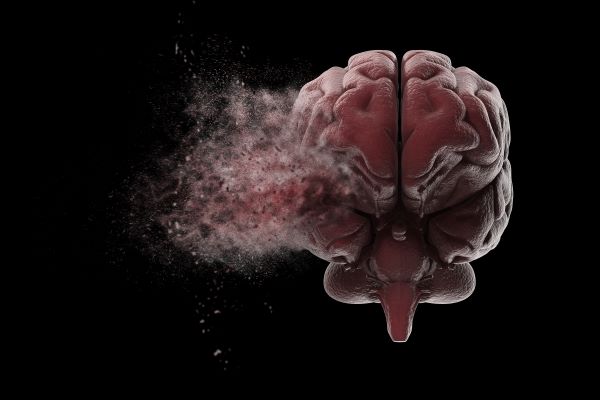
Corporate Anthropology: The human brain hates change. The first reaction is no.
You can change it from a pain to a pleasure in the brain loves to go to pleasure. Healthcare is one of my favorite areas because, to your point, what don’t people see? I could tell you more about this one, but I want to share with you another case study of a client in a manufacturing business, a family firm. They made all kinds of stuff, but they had created an award-winning filler station to go over the water fountains. They had won an innovation award. It wasn’t selling.
They really had about 80% of the market for water fountains, but water fountains were in for code. That made it easy. You had a great water fountain at the right price and the engineers or architects just put them in. This was to go over them and it was originally designed in the airports so that when you went through security with an empty water bottle, you had an easy way to fill it. You have a little counter on there that tells you how many bottles you’ve saved from landfills.
The interesting part was that when I worked with them, they said, “How come nobody’s buying it?” We did our interviewing and found out that it was an extra cost that wasn’t mandated by code, so why bother? We found that the first folks who were buying it were universities or colleges. We dug a little deeper and one of the colleges was having a big campaign to eliminate the sale of plastic water bottles. They really wanted to kill the bottle.
We wrote back. I said, “Do you think that the purpose of this filler station is to fill the bottle? From their perspective, the whole purpose is to kill the bottle.” The whole room had one of those swish moments, which was, “A-ha, it’s our positioning. We’re selling it backwards.” It’s the same thing. A person said that’s why we’re getting all these college students sending us emails asking where they could get the filler station. I have no idea why they’re interested.
I say, “They are in the airport and the person filling the bottle is not necessarily empty bottled, but they have a really different mission and purpose.” I did some more work with them later on, in part to help them reinvent the kitchen sink, which was interesting. You can see sometimes because signals were coming and why you put 150 of these filler stations to kill the bottle. I don’t think they killed the bottle, but I do think that they gave people a way of filling those reusable bottles and not getting the plastic and that’s a cost as well as a landfill problem.
Your question is wonderful. As an anthropologist, what I do is try and find the gap between what people think and what others are actually doing. They can’t see it because the mind has such a great story in it that they see what the mind wants them, the story in their limb is what they can see. They’re not going to change the story, it’s very hard to get past, but I believe it to be true. My chant is the only truth, and there’s no truth.
The only truth is there's no truth. Share on XI love where you ended that story because, as you said, our brain is a meaning-making machine. It’s one of the things that our brain does. Something happens and you make a funny face, or you do what looks to me as though you’re rolling your eyes, but actually what you’re doing is thinking, but because it looks to me like you just rolled your eyes at me, I then make up a story, “Andi doesn’t like me, or Andi thinks what I just said was stupid, or whatever rabbit hole we’re going to go down.”
The mischief is when I start reacting with you, reacting to you as though that is true. What you do as a corporate anthropologist is take that writ large. What are we all collectively thinking that we know? We know that the purpose of our water fountain is to fill up bottles, except it’s universities and airports and probably some other places that may skew the overall population towards a younger demographic.
One of the things that we know about the Millennials and the Gen-Zs is that they have a very high community ethic. They’re really thinking a lot about the planet, about the warming and cooling of the planet, and what’s happening. They’re going to be extra attuned to something like, we have all of these plastic water bottles and it has a cool name, but I cannot remember what it is, but like this great trash dump floating in the ocean that is the size of Texas, that is largely made up of plastic.
Instead of having a plastic water bottle, I could have what I have actually with me right now, which is a steel cup. What’s great about my steel water cup is that I can put ice in it in the morning. I actually did this. My parents and my brother were in town and we went out to the high desert. It was hot. It was early July, and it was about 115 in the high desert. My brother had gone to a retreat to learn about building homes in a very unusual, sustainable way. He was really excited. He wanted to show us this place. We went. I gave each one of them a metal, steel cup and a steel insulated cup, and I put ice and water in it.
The Importance Of Rethinking
When we came back from the desert, there was still ice after having been at 115 degrees. It’s a great invention. The company was looking at it. As you said, they were looking at it backwards, but they didn’t know that. That’s the thing. We have a very hard time. I love it that you wrote the book Rethink, because Adam Grant, I’m sure, also has a book out called ReThinking. It’s such a great and challenging thing to do, to rethink something. Often, we need a guide. We need a cultural anthropologist or we need some other human to help us see what we cannot see. If we cannot see it, we’re never going to be able to rethink it.
No. The book Rethink: Smashing the Myths of Women in Business was an interesting journey for me because it came about because we had launched a three-year program at Washington University. I have called the Simon Initiative for Entrepreneurship. What I realized was, to your point about seeing, is that we were trying to particularly help women entrepreneurs who had ideas, but going from observation to innovation, which is my tagline, was proving difficult. They needed role models. Marian Wright Edelman once said, “If you cannot see it, you cannot be it.”
The brain is looking for what it is. The eleven women in the book, each of whom denied or defied what people said women could or couldn’t do. One is a geologist and women don’t do that. They certainly cannot go into the field, but we can. One is an attorney and I love Andie Kramer’s story because when she was in elementary school, she went to a court and decided then she wanted to be an attorney and her parents had her have lunch with a friend who was an attorney who said, “Don’t ever be a lady lawyer. You’ll never have a family, you’ll never have a life, I know.”
What did she do? She graduated with high honors, became a great attorney, became a partner, and learned a lot about bias in the workplace. In particular, she launched her own business because she got tired of the microaggressions in the big law firm. It was so amazing. She said they were constantly brutalizing, and she performed extremely well and was very successful. The idea is that you can become what you would like to be and don’t let society hold you back with limitations. I think nowadays with JD Vance telling women to stay at home and raise kids.
I’m the third. My kids are the fourth generation of professional women. My grandmother was a professional woman. We all grew up really well and my grandkids are fabulous and the pudding is in the eating. I think that seeing is extremely important because we decide in the eyes, not with the brain and the brain follows with rationale for it. What’s your gut telling you? What do you see? Seeing becomes such an important part of the whole experience.
It is so cool in terms of politics aside with the possibility of having our first female president. It’s interesting that the countries that have already had a female leader and that the United States has not, and that she would be a woman of color compared to all of the other women who see that and then see what is possible. That it is a woman of color is so great in terms of young women seeing that and then having the idea that, “That’s a big old glass ceiling that we have not been able to break.” When that gets broken, hopefully in November, then that’s going to open up a whole new realm of opportunity for women.
Your point is extremely important because times are changing, and the Fourth Industrial Revolution is going to transform what we do at work and what is working. I’m doing some research now on how AI and other technologies are impacting people’s feelings of belonging and inclusion. I’m very interested in change. That’s what we see. To your point about what don’t people see as a failure, that can really open up their minds. I love this wonderful book that I like to offer a mysticology. Humans learn from their mistakes. The more that you do, the more times there’s something that doesn’t go well.
When I coach people, I say, “This is a learning experience. It’s not a mistake, but it’s a time to see things differently than was before.” I do think that humans are ready for the fast-changing times that we’re in. We’re much more prepared for it. Remember, we’ve been evolving for several million years. Those cave paintings 35 or 40,000 years ago are pretty sophisticated. Our minds had a quantum leap.
I don’t know. Some say it was 50,000 years ago, but I think it was longer than that. We are quite unusual. I do think the most interesting part is how the brain feels things first, it goes into the amygdala to see if it’s safe or not, and then it goes up into the neocortex to figure out how to think about it. If you think about it, it really tells you that I’m going to make you run away from that lion chasing you. You’ll fear, but we’ve got to figure out how the unknown can become known so that we can adapt to changing times because it’s all going to be unknown.
We've got to figure out how the unknown can become known so that we can adapt to changing times because it's all going to be unknown. Share on XChange And Its Impact
I love that this is also where our conversation has gone, which is why I love these conversations being organic. How could I have known that we were going to get into change theory and look at the fast way in which things are changing? I heard the CEO of Korn Ferry, which, if our listeners don’t know, is a fairly large international organization that both does research and helps organizations transform. Their CEO recently said, “We have collectively undergone more change in the last four years than any of us have gone through before in our lifetimes.”
I think about my grandparents and when they were born, cars were not ubiquitous during their lifetime and during my parent’s lifetime, televisions became a thing. Phones in every home where you didn’t pick up the receiver and talk to an operator but could actually make a phone call yourself. Now, these computers that we walk around with in our pockets that we can do so much with at the drop of a hat, and now the impact of AI. I heard something about the impact of AI on our curiosity, both looking at it from an augmenting side and from a detracting side, like what the possibilities are looking at both sides of this coin.
I work with organizations as well on change. One of the things that I’ve been thinking about is that often, when change gets launched, a group of people sit around thinking about the change and working through the change. It could have been months, it could have been years that they’ve been noodling and working on this. They’re ready to launch the change. Often, what we do is say, “Team, here’s the new thing. It’s so exciting. Look how pretty and shiny it is. Ready, go.” We forget that we have to honor. There’s a letting go of the old, which can, for some people, depend upon who we are, our life experiences, how our brains are wired, and all those things.
The letting go can be really hard. There’s the transition time in the middle. We’re trying to figure it out. Sometimes we get stuck there. There’s the adopting of the new and the figuring out and the integration. We want to as leaders because we’ve done the process. We’ve figured it all out. In part, we want it to be easy for our team. We just say, “Look, pretty shiny thing. It’s going to be so great.” We forget to pay attention to the letting go, the transition, and then the reintegration and the adoption. I love that you are thinking about the impact of AI and other things on change and how we create change. Tell me more.
I just started to conduct the research. I was particularly interested in humans as herd animals. While we talk about belonging and inclusion, we haven’t quite done a good job of building organizations where those things can be understood from a human perspective. It isn’t casual, but I cannot tell you how many organizations hire new people who don’t ever “fit,” and no effort was made to help them belong or be included. Those are two different things. The question came to me about what this is and the fear that the new technology has so many multiplications, so many multipliers, but to the core of being human, I want to belong to this organization.
The pandemic with the hybrid work has done all kinds of things to rethink what exactly that means. You’ve got technological changes and you have human things that are very important for our safety. With psychological safety and that sense of comfort, and to your point about change, we hold on to the change because the habits in our mind are very comfortable to do things with. We’re thinking about them. We’re doing them until we know how to do that. It’s just done. That’s efficient, but maybe not appropriate. It becomes very interesting. In some ways, the AI is as if the entire team has been just hired. How unfamiliar with the new company and its culture and how we do things here.
How do we do things here? Now, AI has been around for some time. We haven’t paid much attention, but it gives us all kinds of good advice on Amazon and all kinds of good stuff on Google. It’s been subtle, but in a powerful way, it has changed the way we think. Now we’ve got the ability to do something with it. The question is, what shall we do with it that will help us embrace and expand the organization? I mean, does an organization begin to see the new technologies as an expansion of its capabilities? In some ways, I use AI and chat, GPT, as if they’re my copywriters, copy editors, and smart people who I have they’re my staff.
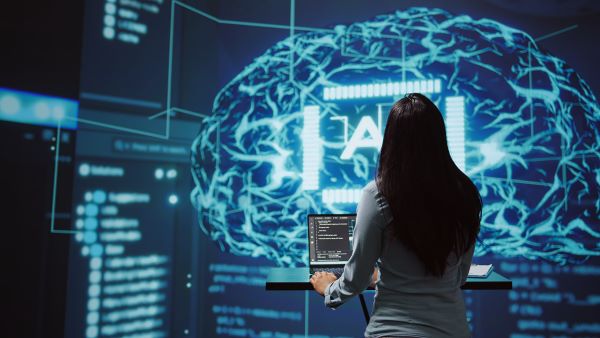
Corporate Anthropology: AI has been subtle but has powerfully changed the way we think.
I don’t have to pay them.
A little bit. I never get sick. Sometimes they don’t give me good stuff, but more often than not, they give me enough to start with and then I can probe deeper. I have a thinking partner and my whole team thinks it’s really a new, talented staff person. For us, it isn’t a distancing tool. It’s an inclusion tool. If you can access it, you can learn more faster and get it done better than if you’re just doing it with your own smarts. I do think what’s important is that you read whatever you create to make sure it’s true, what you would say, but you would do the same thing if you had a copywriter or a copy editor. You cannot push it off on something else or someone else, but you do have a support team now.
I have found that if I say, “Can you please give me X or help me think about or can you wireframe a new section of my website or whatever? Can you give me source links?” It will, for wherever it has source links. It will also say, “I cannot find a good source for this.” This then alerts me to, “If you cannot find a good source for it and you have a lot of resources available, then maybe that’s not entirely accurate. I’m going to leave that out of my thinking, my writing, my formulation, or whatever it is.”
The other part of that, though, is how many ways you can find something. There’s what you do. There’s Google, there’s Bing, there’s lots of resources. When they pull up research, you still have to read the stuff and figure out what it means. Regardless of who’s helping you outline or develop, the brain has to now be engaged in it, including it. It’s another staff person that needs to be included in the process. If you’re not smart, and you take it for what it is, just as is, you’re going to get burned.
There’s no need to do that. It’s easy enough to enjoy it. I’m just thinking about the internet. I met somebody not too long ago who said, “I’m never going to use AI.” I teach English to non-English speakers, and then I’m going to use AI. I say, “Why are you handicapping them?” Why are you putting handcuffs on them? It’s not really theirs. I said, “Whose is it?”
At the end of the day, you’re trying to give them tools to be communicative, and then I met people years ago who were never going to use the internet for this or that. I used to use a travel agent. I don’t anymore. I went to Vietnam, I found one in Saigon who’s really good. I think that trust is built over time with a sense that there are good people, but be your own and scrutinous for your own purposes. The times they are changing, and not everybody loves change.
Most of us have a wary, at best, relationship with change. Some were like, “Bring it on.” Most of us are like, “I’m comfy over here.” I have a friend who says, “Nobody grows at 72 degrees.” I loved it when he first said it. I was like, “That’s brilliant. May I adopt that?” He’s a very generous man and said, “Yes, please, of course.” We like it at 72 degrees. It is comfortable at 72 degrees. That’s not when we’re growing and learning and stretching. We’re growing and learning and stretching when it’s challenging.
Change is one of the biggest challenges that we get to do. Even if it’s a change of our own accord, even if we’ve designed the change, even if we want the change, it can still be challenging. I was talking with a young mom one tme and she has wanted to be a mom forever. She’s so excited about this baby that is coming yet she is feeling bad about the loss of herself as a more individual individual. She is feeling the beginnings of things like my partner and I were not going to be able to just jump up and do whatever or hop in the car for an afternoon and go driving, or things are changing.
Even though this is a change that she has wanted so badly, she was feeling really guilty about all of these other thoughts until I helped her realize, “No, you’re going through a change.” We always have a challenge. Even if it’s just a teeny challenge, we always have a challenge with letting go of what was because it was 72 degrees. We knew how to do that. We were comfortable with that. It does not mean that you’re not excited about your beautiful baby girl who’s coming. It just means you’re in a chain.
Yes. Growing up means giving up. It’s interesting.
That, too. This has been such a wonderful and rich and unexpected conversation in terms of I knew it was going to be wonderful and rich, but I didn’t know where we would go. Thank you so much for sharing with me and with our listeners that there’s even a thing out there called being a corporate anthropologist. I had never heard of that until you and I first met. Thanks for sharing your wisdom, your humor, your great case studies and stories, and your strategy of sitting around. What does that lead to, and what is the richness that then gets created? It has been such a joy having you here with us.
It has been a pleasure to share. Just remind your audience that they, too, have the eyes of an anthropologist. Instead of assuming, just sit and listen. Have people tell you stories, watch what’s actually happening. Try to be an observer sometimes, maybe a participant observer, but don’t always know until you can sit back and watch for a little bit with some distance and perspective. It becomes an interesting way of training your mind to actually see, feel, and think in new ways.
Instead of assuming, just sit and listen. Have people tell you stories. Share on XHave the ability to rethink.
Yes, right.
Thank you so much. Remember, great leaders make great teams. Until next time.
Important Links
- Dr. Andi Simon
- Women Mean Business: Over 500 Insights from Extraordinary Leaders to Spark Your Success.
- On the Brink: A Fresh Lens to Take Your Business to New Heights
- Rethink: Smashing the Myths of Women in Business
- ReThinking
- SimonAssociates.net
- Instagram – Andi Simon
- LinkedIn – Andi Simon
About Andi Simon
 Dr. Andi Simon, a distinguished corporate anthropologist, specializes in guiding companies through transformative change. With two acclaimed books and her latest release, “Women Mean Business: Over 500 Insights from Extraordinary Leaders to Spark Your Success,” coauthored with Edie Fraser and Robyn Freedman Spizman, she champions culture development and leadership evolution.
Dr. Andi Simon, a distinguished corporate anthropologist, specializes in guiding companies through transformative change. With two acclaimed books and her latest release, “Women Mean Business: Over 500 Insights from Extraordinary Leaders to Spark Your Success,” coauthored with Edie Fraser and Robyn Freedman Spizman, she champions culture development and leadership evolution.
As Founder and CEO of Simon Associates Management Consultants, an award-winning agency, she infuses anthropological principles into businesses, fostering innovative perspectives. Her podcast, “On the Brink with Andi Simon,” ranks among the top 5% globally, reflecting her dedication to sharing insights on organizational reinvention.




